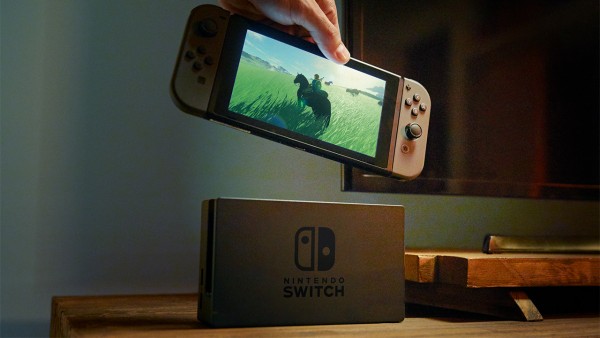While Nintendo has already announced the Nintendo Switch at this point, there are still several unanswered questions on the hardware side of things. However, this week, reports have revealed the CPU and GPU clock speeds of the Switch while in mobile mode and while docked. We also know a little bit more about the Nvidia chip inside of the console.
According to Digital Foundry's sources, the Nintendo Switch packs a custom Tegra X1 chip, which is based on the Maxwell architecture and first appeared in the Nvidia Shield TV. This is important to note as back when Nvidia announced that it was providing the chip for the Switch, the wording of its post made it sound like perhaps it would be based on the newer Pascal architecture.
On the CPU side of things, the Nintendo Switch will be running at 1020MHz at all times, whether docked or not. However, GPU clock speeds will get a boost when docked, jumping from 307.2MHz up to 768MHz. This essentially means that when you use the Switch in mobile mode, the GPU will be running at 40 percent of its maximum speed.
In any case, the Switch's version of the Tegra X1 is cut down compared to the one found in the Shield TV. The fully unlocked chip has a CPU that runs closer to 2GHz and its GPU runs at around 1GHz. However, the Shield TV is not a battery powered device, so it is able to use up more energy. Nintendo doesn't have that luxury with a portable console.
Games on the Switch will be running at 720p while in mobile mode but will apparently scale up to 1080p when docked and plugged into a TV.
KitGuru Says: The Nintendo Switch isn't going to be beating out the current home consoles in terms of raw power. However, Nintendo dropped out of the hardware race quite some time ago and now focusses more on trying to provide quality games. Whether or not these cut back specs will hinder third-party support is still up in the air though, it certainly did when it came to the Wii U but perhaps things will be different with the Switch.
 KitGuru KitGuru.net – Tech News | Hardware News | Hardware Reviews | IOS | Mobile | Gaming | Graphics Cards
KitGuru KitGuru.net – Tech News | Hardware News | Hardware Reviews | IOS | Mobile | Gaming | Graphics Cards




Cool idea for a console but with these spec’s it should have just been kept a handheld device. I think they should have actually released a full console with better spec’s for the living room. Yes I know Horse power is not everything but with the focus on 4K and VR it seems this device will come up short against the new improved PS4 pro and the new XBox one when released for Christmas 2017 season. My take on this is we already have plenty of mobile devices that can do what the switch can handle for mobile gaming.
I know there will be some that will argue with me about this but I just think they dropped the ball they needed 2 devices released and not try to jam pack 1 device to try to handle the job of mobile and living room. Yes I am sure the new Nintendo exclusives like Mario etc will look better in their new versions for this device than they did for the WEE-U but lets face it there is only so much Mario a person can take before wanting more.
For me, the decision to merge home and mobile console is a great idea, one I hoped could be achieved in an alternate way with the psvita back then when they started announcing lots of PS3 IPs on their portable (but didn’t actually delivered).
Ok, the mobile version of the Switch is a little too big to be called a handheld console, but after checking with most of my friends and co-workers, they mostly use their console “seated” (at home or during travel) without a care for the battery, and without a real care for its size since they transport it in they bag and not their pocket.
I kind of discovered that I was the only one in my circle to never use my handheld console (psvita) at home (mostly during transportation from home to work), and keeping it in my mantle’s pocket.
But none the less, the concept is great for lot of people like me who don’t have that much time to monopolize the living room, but lots of time to play outside, which means I could switch from home mode to handheld mode and keep playing every games usually targeting a home console.
To bad, the home version is so underpowered that it basically makes it a secondary console, like the Wii U. Maybe I will take it at the end of its life, for the exclusive titles
You actually make some great points in your comment. I agree it is a good idea but I also think they could have put hardware in the base station that upped the horsepower when in console mode which would have allowed for high def games that could have been played maybe not 4K mind you. That way you could have the best of both worlds a fairly good hand held device and a much better equipped console when in the living room. Some here would say oh well then you have to buy different games for different purposes well you would be right. You would have your favorites when on the go and you would have your favorites when sitting on the couch or if done in a way maybe both modes could support the same games but at different levels of detail and resolutions.
I also would have liked a better hardware for home use, which could be compared to PS4/X1 (not even talking about Pro/Scorpio).
The current hardware is underclocked during mobile use, ensuring better battery life while not needing full power for a smaller screen/resolution, which is a great idea, but the home version is underwhelming.
I wonder if Nintendo studios knew the final specifications early enough, or if the switch to Tegra X1 instead of upcoming X2 was made really late, hindering the development.